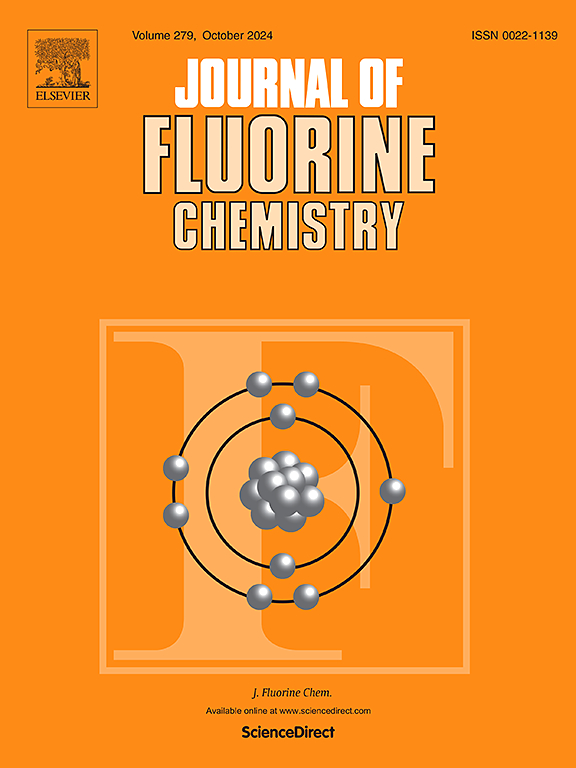微波辅助硼氢化钠/镧系稀土氯化物体系还原液态氟弹性体末端羧基
IF 1.7
4区 化学
Q3 CHEMISTRY, INORGANIC & NUCLEAR
引用次数: 0
摘要
以聚偏氟乙烯-共六氟丙烯为原料,采用NaBH4/氯化镧(MCl3;M = La, Ce, Sm, Gd)催化体系。通过FTIR, UV-Vis, 1H NMR, GPC和滴定分析等综合结构表征证实了末端羧基(- cooh)转化为羟基(- oh),同时主碳-碳双键(-C = C-)还原为单键(-C-C-)。系统评价表明,NaBH4/CeCl3、NaBH4/SmCl3和NaBH4/GdCl3体系的还原效率超过80%。采用NaBH4/SmCl3体系进行工艺优化,确定了最佳工艺参数:微波辐照功率为320 W, SmCl3/-COOH摩尔比为2:1,底物/溶剂比为1:10 (g/mL),转化率为84.60%。微波方法显示出显著的时间效率,与需要数小时的传统热方法相比,在4分钟内实现80%的转换。这一加速过程显著增强了反应动力学,同时保持结构保真度,如全面的光谱和色谱分析所证明的那样。这项工作为精确的氟橡胶官能团修饰建立了一个强大的微波辅助平台,在先进的含氟聚合物合成中具有潜在的应用前景。本文章由计算机程序翻译,如有差异,请以英文原文为准。

Microwave-assisted sodium borohydride/lanthanide rare earth chlorides system for reduction of terminal carboxyl groups in liquid fluoroelastomer
Liquid terminal carboxyl fluororubber (LTCFs) derived from poly(vinylidene fluoride-co-hexafluoropropylene) was efficiently converted to liquid terminal hydroxyl fluororubber (LTHFs) through a microwave-assisted reduction process employing NaBH4/lanthanide chloride (MCl3; M = La, Ce, Sm, Gd) catalytic systems. Comprehensive structural characterization via FTIR, UV–Vis, 1H NMR, GPC, and titration analyses confirmed the transformation of terminal carboxyl groups (-COOH) to hydroxyl groups (-OH) while simultaneously reducing backbone carbon-carbon double bonds (-C = C-) to single bonds (-C-C-). Systematic evaluation revealed NaBH4/CeCl3, NaBH4/SmCl3, and NaBH4/GdCl3 systems achieved exceptional reduction efficiencies exceeding 80 %. Process optimization using the NaBH4/SmCl3 system established optimal parameters: 4 min microwave irradiation at 320 W power, SmCl3/-COOH molar ratio of 2:1, and substrate/solvent ratio of 1:10 (g/mL), yielding 84.60 % conversion efficiency. The microwave methodology demonstrated remarkable temporal efficiency, achieving >80 % conversion within 4 min compared to conventional thermal methods requiring hours. This accelerated process significantly enhanced reaction kinetics while maintaining structural fidelity, as evidenced by comprehensive spectroscopic and chromatographic analyses. The work establishes a robust microwave-assisted platform for precise fluororubber functional group modification with potential applications in advanced fluoropolymer synthesis.
求助全文
通过发布文献求助,成功后即可免费获取论文全文。
去求助
来源期刊

Journal of Fluorine Chemistry
化学-无机化学与核化学
CiteScore
3.80
自引率
10.50%
发文量
99
审稿时长
33 days
期刊介绍:
The Journal of Fluorine Chemistry contains reviews, original papers and short communications. The journal covers all aspects of pure and applied research on the chemistry as well as on the applications of fluorine, and of compounds or materials where fluorine exercises significant effects. This can include all chemistry research areas (inorganic, organic, organometallic, macromolecular and physical chemistry) but also includes papers on biological/biochemical related aspects of Fluorine chemistry as well as medicinal, agrochemical and pharmacological research. The Journal of Fluorine Chemistry also publishes environmental and industrial papers dealing with aspects of Fluorine chemistry on energy and material sciences. Preparative and physico-chemical investigations as well as theoretical, structural and mechanistic aspects are covered. The Journal, however, does not accept work of purely routine nature.
For reviews and special issues on particular topics of fluorine chemistry or from selected symposia, please contact the Regional Editors for further details.
 求助内容:
求助内容: 应助结果提醒方式:
应助结果提醒方式:


